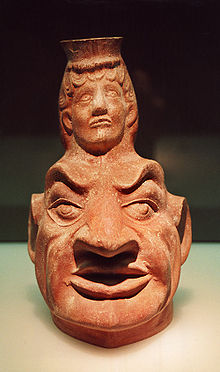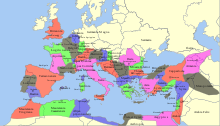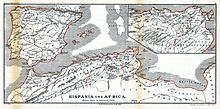Africa (Roman province)
![]()
The title of this article is ambiguous. For other meanings, see Africa (disambiguation).
Africa was the Latin name for a Roman province in ancient times. In contrast, for the continent of Africa (except Egypt and Aithiopia), more precisely at first only for North Africa west of the Nile, the region known to the Romans from this continent, the name Libya was often used (as already by the Greeks).
The province consisted of the former heartland of the Carthaginian Empire and was established after the Punic Wars in 146 BC. It included present-day Tunisia and parts of Algeria and Libya. The border between the Roman province and the Numidian kingdom was the Fossa regia, a demarcation line drawn by Scipio the Younger. Since the Romans had completely destroyed Carthage, Utica first became the capital of the new province.
In 105 BC, after Gaius Marius' victory over Jugurtha, western parts of Numidia were incorporated into Roman territory, and after Caesar's victory at Thapsus in 46 BC, Caesar formed the province of Africa nova ("new Africa") from the territory of the Numidian king Jubas I, a follower of the defeated Pompey. Its territory included large parts of Numidia (in present-day Algeria) and Tripolitania (in present-day Libya). The existing province was henceforth called Africa vetus ("old Africa") or Africa propria ("proper Africa").
In 27 BC, Augustus united the provinces of Africa vetus and Africa nova to form Africa proconsularis. The capital was Colonia Iulia Concordia Carthago, founded in 29 BC on the site of the former Carthage. The governorship of Africa, along with that of Asia, was the most prestigious, especially since the proconsul of Africa was initially the only senatorial governor to hold independent command of a Roman legion (Legio III Augusta) - something otherwise reserved for imperial legates. During the reign of Emperor Septimius Severus (193-211), the province of Numidia was detached from the previous province.
Under Diocletian, the old province was divided again at the beginning of Late Antiquity around 300: into Africa proconsularis (→ Zeugitana), Byzacena, and Tripolitiana. To these were added Mauretania Sitifensis and Mauretania Caesariensis, which lay farther west. These six provinces formed late Roman North Africa.
The province was generally considered one of the richest in the Roman Empire and the granary of the Western Empire, Carthage even being the second largest city in the West right after Rome, as well as the province in general being highly urbanized. Its highest period of prosperity fell in the 2nd and early 3rd centuries; a renewed flourishing began around 300 and lasted until the 5th century. Roman emperors from the House of Severa were originally from Leptis Magna, a city in the province of Africa. Important Christian figures also came from the province (such as Lactantius and Marius Victorinus) or lived there for some time (Augustine of Hippo), as did the late ancient poet Gorippus. The extent to which the Punic or Carthaginian language continued to be used as a colloquial language alongside Latin is unclear and disputed.
Christians are attested early in the province (the first evidence of the existence of African Christians dates from the late 2nd century) - here church teachers such as Tertullian, Cyprian and later Augustine were the first to develop a Christian theology in Latin - and the community of Carthage was long the great competitor of the bishop of Rome for the claim to leadership in the West. The Christians of Africa remained predominantly Nicene (after the 4th/5th century clashes with the Donatists, who formed a significant minority), despite the incursion of the Arian Vandals, who conquered Africa in the 1930s. The invaders established a de facto empire of their own here and usurped naval supremacy in the western Mediterranean. The loss of North Africa, on whose grain Italy continued to be heavily dependent, played a not insignificant role in the downfall of Western Rome. Meanwhile, late antique culture continued to be cultivated among the Vandals, whose ruling class was rapidly becoming Romanized.
In the 6th century, Africa was reconquered by the Eastern Roman general Belisar on behalf of Emperor Justinian (533/34). The territory was subsequently placed under the authority of a magister militum per Africam and administered by a praetorian prefect. The view of older scholars that the reconquest was the decisive blow for the economy of Africa in late antiquity has since been revised by archaeological and epigraphic investigations: Rather, the area experienced another post-conquest flourishing and was politico-militarily reorganized in the late 6th century as the exarchate of Carthage. Politically, economically, and culturally, Eastern Roman Africa remained closely linked to the Mediterranean world.
The area fell to the Islamic Arabs from the middle of the 7th century, who called it Ifrīqiya. With the conquest of Carthage in 698, the history of the Roman province of Africa was finally ended; Roman-Christian culture also soon came to an end here. Unlike the Eastern churches (Copts, Syrians, Armenians, Greeks), which continued for centuries under Islamic rule, North African Christianity disappeared completely.

Export hit from the province of Africa proconsularis: vessels made of Sigillata Chiara

Roman provinces under Trajan (117 AD)

Map of Africa
See also
- List of governors of Africa
Questions and Answers
Q: What was the Roman province of Africa?
A: The Roman province of Africa was established after the Romans defeated Carthage in the Third Punic War.
Q: What territories were included in the Roman province of Africa?
A: The Roman province of Africa roughly included the territory of present-day northern Tunisia, north-eastern Algeria and the Mediterranean coast of modern-day western Libya along the Syrtis Minor.
Q: Who named the same region as the original province Ifriqiya?
A: The Arabs later named roughly the same region as the original province Ifriqiya.
Q: What does Ifriqiya mean?
A: Ifriqiya is another word for Africa.
Q: When was the Roman province of Africa established?
A: The Roman province of Africa was established after the Romans defeated Carthage in the Third Punic War.
Q: What led to the establishment of the Roman province of Africa?
A: The Romans defeated Carthage in the Third Punic War, which led to the establishment of the Roman province of Africa.
Q: Which modern-day countries were part of the Roman province of Africa?
A: The Roman province of Africa included present-day northern Tunisia, northeast Algeria, and the Mediterranean coast of modern-day western Libya along the Syrtis Minor.
Search within the encyclopedia